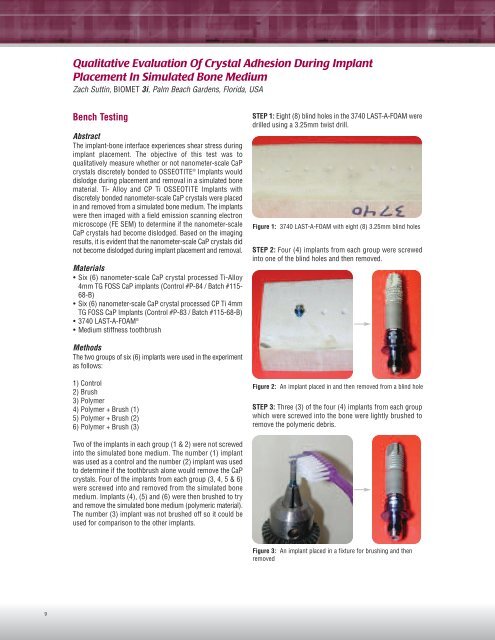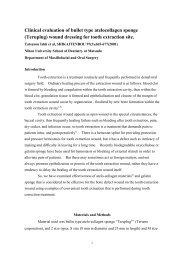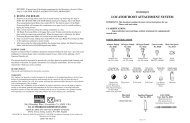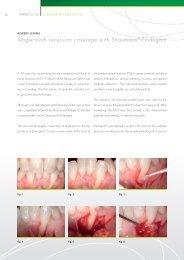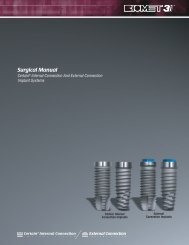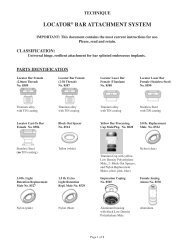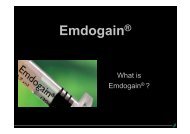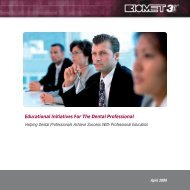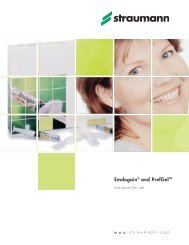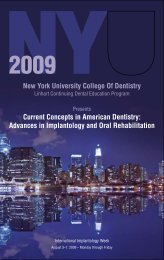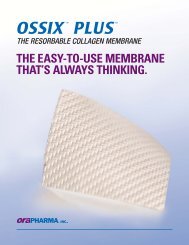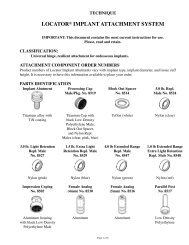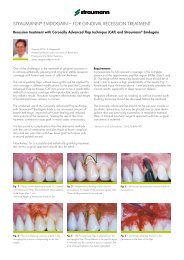Research Dossier
Research Dossier
Research Dossier
- No tags were found...
You also want an ePaper? Increase the reach of your titles
YUMPU automatically turns print PDFs into web optimized ePapers that Google loves.
Qualitative Evaluation Of Crystal Adhesion During ImplantPlacement In Simulated Bone MediumZach Suttin, BIOMET 3i, Palm Beach Gardens, Florida, USABench TestingAbstractThe implant-bone interface experiences shear stress duringimplant placement. The objective of this test was toqualitatively measure whether or not nanometer-scale CaPcrystals discretely bonded to OSSEOTITE ® Implants woulddislodge during placement and removal in a simulated bonematerial. Ti- Alloy and CP Ti OSSEOTITE Implants withdiscretely bonded nanometer-scale CaP crystals were placedin and removed from a simulated bone medium. The implantswere then imaged with a field emission scanning electronmicroscope (FE SEM) to determine if the nanometer-scaleCaP crystals had become dislodged. Based on the imagingresults, it is evident that the nanometer-scale CaP crystals didnot become dislodged during implant placement and removal.Materials• Six (6) nanometer-scale CaP crystal processed Ti-Alloy4mm TG FOSS CaP implants (Control #P-84 / Batch #115-68-B)• Six (6) nanometer-scale CaP crystal processed CP Ti 4mmTG FOSS CaP Implants (Control #P-83 / Batch #115-68-B)• 3740 LAST-A-FOAM ®• Medium stiffness toothbrushSTEP 1: Eight (8) blind holes in the 3740 LAST-A-FOAM weredrilled using a 3.25mm twist drill.Figure 1: 3740 LAST-A-FOAM with eight (8) 3.25mm blind holesSTEP 2: Four (4) implants from each group were screwedinto one of the blind holes and then removed.MethodsThe two groups of six (6) implants were used in the experimentas follows:1) Control2) Brush3) Polymer4) Polymer + Brush (1)5) Polymer + Brush (2)6) Polymer + Brush (3)Figure 2: An implant placed in and then removed from a blind holeSTEP 3: Three (3) of the four (4) implants from each groupwhich were screwed into the bone were lightly brushed toremove the polymeric debris.Two of the implants in each group (1 & 2) were not screwedinto the simulated bone medium. The number (1) implantwas used as a control and the number (2) implant was usedto determine if the toothbrush alone would remove the CaPcrystals. Four of the implants from each group (3, 4, 5 & 6)were screwed into and removed from the simulated bonemedium. Implants (4), (5) and (6) were then brushed to tryand remove the simulated bone medium (polymeric material).The number (3) implant was not brushed off so it could beused for comparison to the other implants.Figure 3: An implant placed in a fixture for brushing and thenremoved9


